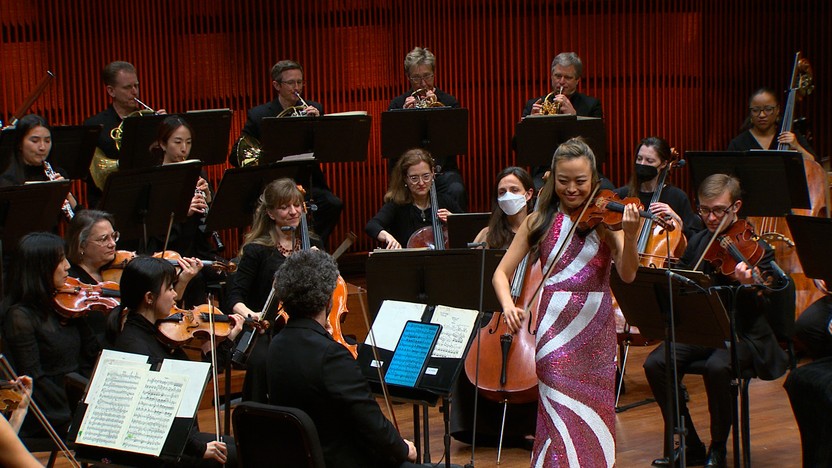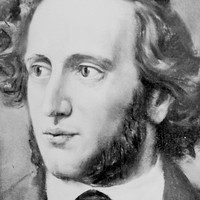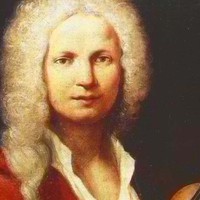Musician Appreciation Concert 2023

Sponsored By

Sponsored By




 Watch Video
Watch Video
Felix Mendelssohn took full advantage of the opportunities that came with his family’s position of privilege as successful bankers. This was a child who celebrated his 12th birthday with a private performance of his first musical, in a fully staged production at his house in Berlin, featuring members of the royal orchestra!
At the age of twenty, Felix Mendelssohn performed a typical rite of passage for well-heeled young men, embarking on a “grand tour” of Europe. On August 7, 1829, he reached the Hebrides Islands off the western coast of Scotland, where the scenery inspired him to scribble a few phrases of music into a letter sent home to Berlin. His boat voyage the next day to the famous Fingal’s Cave provided additional fodder for a new work he began plotting.
After continuing on to Rome, Mendelssohn fashioned his Hebrides ideas into a concert overture as a birthday present for his father, under the original title of Lonely Island. He tinkered with the score and the title several more times — various drafts were known as The Isles of Fingal, Fingal’s Cave and The Hebrides — until he signed off on a definitive version in 1832. His very first sketch remained in place as the overture’s nucleus, as heard in the rocking, wave-like cascades that appear in the opening measures.
Aaron Grad ©2023
 Watch Video
Watch Video
Antonio Vivaldi came of age during a glorious boom in violin construction and technique around northern Italy, including his native Venice, where his own father was a professional violinist. With a job there teaching violin at a school for orphaned girls, Vivaldi was able to use his talented students to test out his compositions, especially the many concertos — more than 500 by the end of his life — that built on advances made by local peers over the past several decades. Vivaldi developed or codified some of the most important aspects of concerto style, such as the fast-slow-fast sequence of movements and the use of ritornello structure as a way to differentiate sections for the soloist and full ensemble.
After the violin, the instrument that appears most frequently as a concerto soloist in Vivaldi’s catalog is an unlikely choice: the bassoon. There are 39 surviving bassoon concertos (two of which are incomplete), with no clear explanation for their origin. Vivaldi dedicated one to a Venetian musician, and another to a Bohemian count, but there must also have been a worthy soloist at the school where Vivaldi worked at various times between 1703 and 1740.
The bassoon was in a transitional period in Vivaldi’s day. Its Renaissance-era precursor, the dulcian, was fading away, supplanted by the bassoons designed in the late 1600s in France and Germany. In the early 1700s, the bassoon’s usual role was to augment the bass line as part of the basso continuo group, along with cello, bass, harpsichord, or any other number of bass instruments. It was rare for the bassoon to appear as a featured voice, all the more so in Italy. But Vivaldi’s writing demonstrates an intimate knowledge of the instrument’s expressive capabilities, from its growling bass notes to its smooth lyricism in its tenor range. He also understood how effectively the instrument could leap between ranges, as heard in a particularly virtuosic flurry of slurs and jumps in the first movement.
The Larghetto slow movement supports the bassoon’s intimate melody with sparse and elegant accompaniment, sometimes using just a single cello and harpsichord, and other times dropping the bass group out so just the upper strings can pulse the gentle harmonies. In the very fast finale, strings of triplets in the solo part show off the bassoon’s underappreciated agility.
Aaron Grad ©2023
 Watch Video
Watch Video
Felix Mendelssohn, the grandson of the great Jewish philosopher Moses Mendelssohn and the son of a prominent banker, was afforded every opportunity to develop his considerable musical talents. As a teenager in Berlin, when he wasn’t composing or mounting performances in his family’s private theater, he gathered to play chamber music with other talented youngsters, including Ferdinand David, a virtuoso violinist one year his junior. The two budding stars remained lifelong friends and collaborators.
When Mendelssohn became Music Director of the Leipzig Gewandhaus Orchestra in 1835, he invited David to join the orchestra as concertmaster. “I’d like to write a violin concerto for you next winter,” Mendelssohn went on to suggest in 1838. “One in E-minor sticks in my head, the beginning of which will not leave me in peace.”
Mendelssohn waited until the summer of 1844 to flesh out the concerto, a process that involved extensive correspondence with David about advanced violin technique. This impeccable concerto turned out to be the last orchestral score that Mendelssohn completed; two years after its 1845 premiere in Leipzig, he died following a series of strokes.
Brass and timpani herald the arrival of the finale in the sunny home key of E-major. As a contrast to the flirty main theme, a regal secondary theme injects new grandeur and gravitas. It is fitting that this last big tune reworks the rhythms and intervals of the violin’s initial melody from the opening movement, such that an idea that first appeared in the concerto as a lonely question returns transformed into a communal affirmation.
Aaron Grad ©2023
 Watch Video
Watch Video
After leaving stormy Scotland, which inspired the Hebrides Overture and the Symphony No. 3 (“Scottish”), the 20-year-old Mendelssohn continued his grand tour in Italy, sparking a symphony that, according to the composer, was “the jolliest piece I have ever done.”
Mendelssohn sketched part of that symphony while in Italy in 1830–31, and he completed the work in 1833, using it to fulfill a prestigious commission from the Philharmonic Society of London, the same group that had commissioned Ludwig van Beethoven’s Ninth Symphony. Mendelssohn made substantial revisions to the symphony’s final three movements in 1834, and he intended to revise the first movement, too, but he postponed that task and finally suppressed the symphony altogether. The work was published posthumously as the Symphony No. 4, although it was actually composed third. This performance restores the original conception of the 1833 version, using a critical edition prepared by the conductor Christopher Hogwood.
Mendelssohn’s bright impressions of Italy are borne out by the bouncing themes and running triplet pulse of the Allegro vivace movement that opens the symphony. Still, this is no mere musical “postcard” — just note the finely wrought development section, which shows the work of a composer equally fluent in Johann Sebastian Bach’s formal counterpoint and Beethoven’s obsessive manipulation of recurring themes. The Andante con moto may have been influenced by a religious processional Mendelssohn witnessed in Naples, an image that fits with the movement’s walking bass and grave harmonies.
The moderate pace and smooth flow of third movement resemble the symphonic minuets of Mozart and Haydn, as opposed to the more rambunctious scherzos popularized by Beethoven. In the contrasting trio section, the horns and bassoons indulge in spacious phrases that impart an outdoor quality, until the mood turns momentarily menacing with the interjection of trumpets, timpani, and a stern minor key.
For the symphony’s whirlwind finale, Mendelssohn borrowed lively rhythmic patterns from Italian folk dancing. He named the movement after the saltarello, a dance from central Italy defined by its fast triplet pulse and its leaping movements.
Aaron Grad ©2023
This special concert is a fundraising event and is not eligible for ticket exchanges, membership ticket reservations, guest pass redemption, or free child or student tickets. Additional restrictions may apply. Visit thespco.org/appreciation for details.
This event will be streamed live for free via the SPCO Concert Library.
We hope all viewers will make a contribution to the event to support our wonderful musicians.
Can't attend, but still want to support the musicians of the SPCO? You can make a gift directly. All proceeds from this fundraising event will go to SPCO musicians in appreciation for the passion, dedication and incredible artistry they share every year. Make your gift today.
Event Packages
Ticket packages are also available for purchase. To reserve a Gold or Silver event package, please contact Jasmine Magner at 651.292.6988 or jmagner@spcomail.org.
Gold – $10,000 (includes 10 premium tickets)
Silver – $5,000 (includes 6 premium tickets)
Note: Your ticket purchase total minus $15 per ticket is tax-deductible to the extent allowed by law. Please note that it is our policy that donations made to this event are non-refundable.
Increase your support for the musicians with a special matching gift opportunity
The SPCO Board of Directors and Governing Members will match all new or increased gifts for the Musician Appreciation Concert. If you supported last year’s Musician Appreciation Concert, we hope you’ll increase your gift this year, and the amount of your increase will be matched. If you didn’t support last year’s event, your entire gift this year will be matched!
What portion of my ticket purchase is tax deductible?
The fair market value of each ticket is $15; that means the remaining amount of the purchase price for each ticket to this special event is a donation to the musicians of the SPCO.
Example: An SPCO fan purchases a premium ticket for $1,000. $985 of the purchase price is a tax-deductible donation; the remaining $15 is the cost of admission. Please note that it is our policy that donations made to this event are non-refundable.
I cannot make it or do not wish to attend in-person. Is there an option to participate virtually?
Yes! This special event will be streamed live free of charge in the SPCO Concert Library and available for on-demand replay through the end of Tuesday, March 7. Because this event is a special celebration benefiting the musicians of the SPCO, we hope that all virtual attendees will make a donation. See above for details on how to make your gift.
What happens to my ticket(s) if I can no longer attend?
Please contact the Ticket Office to turn your tickets back as a tax-deductible donation to the musicians of the SPCO or request a refund. This concert is a special fundraising event, so tickets cannot be exchanged from this event into another performance. The Ticket Office can be reached by phone Monday through Friday 12pm–5pm at 651.291.1144 or by email at tickets@spcomail.org.
Please note that the portion of each ticket purchase that is a tax-deductible donation is not refundable. For example: An SPCO fan purchases a premium ticket for $1,000. They wish to refund their ticket. The SPCO will refund $15, the fair market value of admission. The remaining $985 is a non-refundable donation to the musicians of the SPCO.
What is the SPCO’s current COVID-19 health and safety plan?
Please visit thespco.org/safe for the SPCO’s complete Health and Safety Plan. We recognize that there will be a wide range of comfort levels amongst audience members. Masks will not be required but are welcomed and encouraged, and previous venue capacity limits have been lifted. We ask that guests stay home if they are sick or if they are exposed to COVID-19.
Get driving directions and find nearby parking.
Find dining options close to the venue.
View seating charts to find out where you'll be seating.
SPCO concerts are made possible by audience contributions.
For exclusive discounts, behind-the-scenes info, and more:
Sign up for our email club!
